The “onion syndrome” in projects:
7 practical tips to nip it in the bud
“The art of life is a constant readjustment to our surroundings.” Okakura Kakuzo
Imagine or recall a case when an additional project pops up in your work. A brief screening shows that probably it won’t be too complicated despite a lot of minor differences from what you have done before. Your working schedule is full of other important or urgent tasks and you simply do not have time for long cogitation and analysis. You ideate how the outcome might look like and know that deviations are natural, unavoidable, and usually they can be fixed during project execution. Raw estimates of the proposed budget and deadlines sound fair, project work looks more or less clear and not scary, ergo you are ready to start your straight path to the project’s success.
Murphy’s law says: “anything that can go wrong will go wrong” and suddenly your project illustrates it. In the beginning, there are light signs of potential complications (add-on features or requirements, new stakeholders, another set of deliverables, etc.) that you might not notice or ignore to keep on moving ahead. After some time, you face an issue and might skip or postpone it instead of fixing it. You continue to move forward, ignoring or underestimating consequences. Then another complication pops up and another one, and then some more. Problems are growing like a snowball. The project becomes hardly controlled and its complexity unexpectedly runs to the sky.
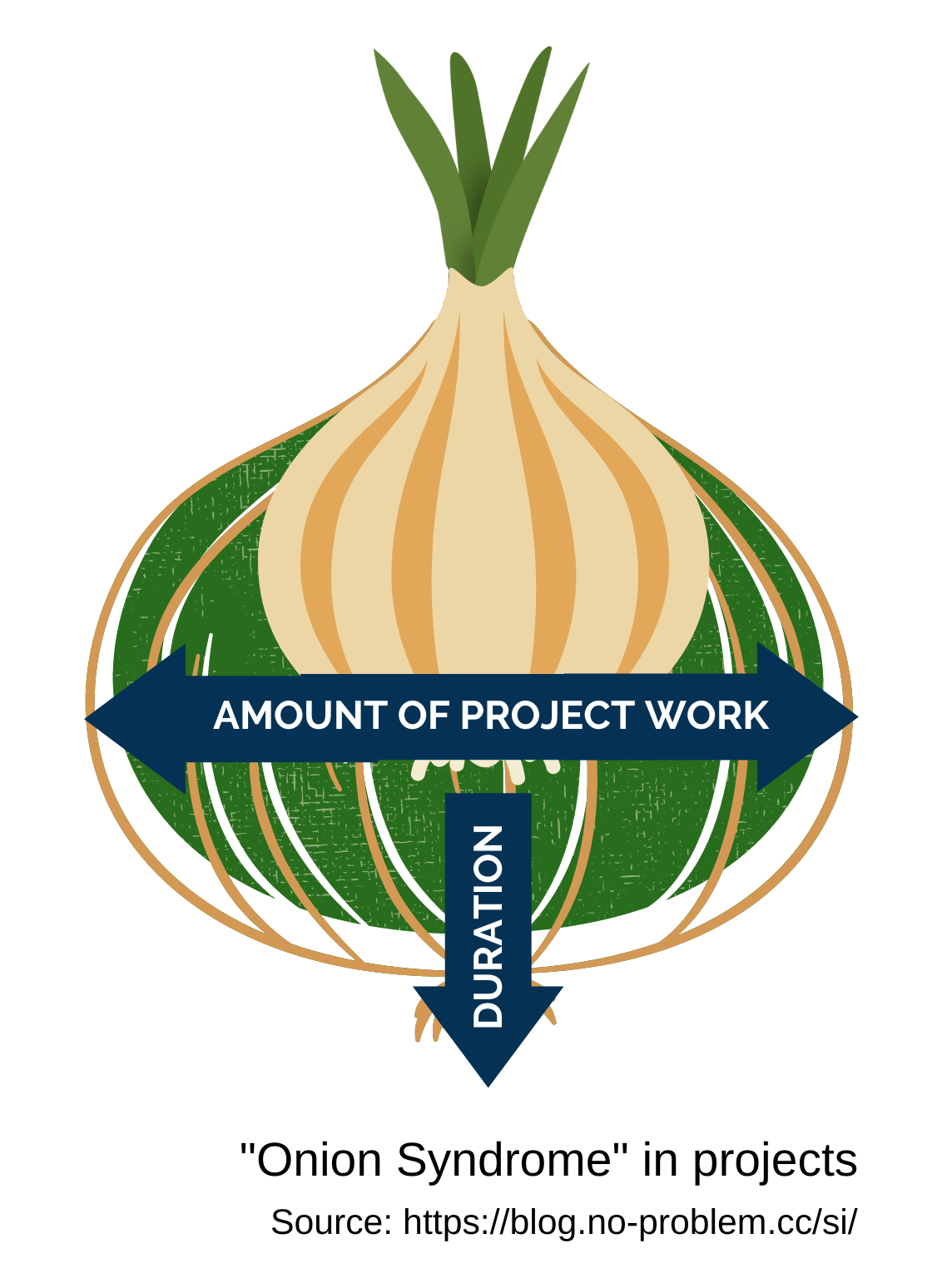 To patch and fix the appeared troubles, the amount of project work swells, the project duration lengthens, and the project path takes the shape of a bulb.
To patch and fix the appeared troubles, the amount of project work swells, the project duration lengthens, and the project path takes the shape of a bulb.
If this situation sounds familiar to you, you have already experienced the ‘onion syndrome’, where a bulb size depends on how many problems were piled up and how long necessary corrective actions were postponed. In most cases, there is a good chance to nip it in the bud or minimize its effect by monitoring obvious but critically important aspects of any project.
Clear vision
The first preventive action to diminish an onion’s stature is to have an explicit project goal and its relation to business strategy. Each project is unique and has its features. It lies at the intersection of the three interdependent targets: time, budget, and outcome, and aims to create a certain (in)tangible business value.
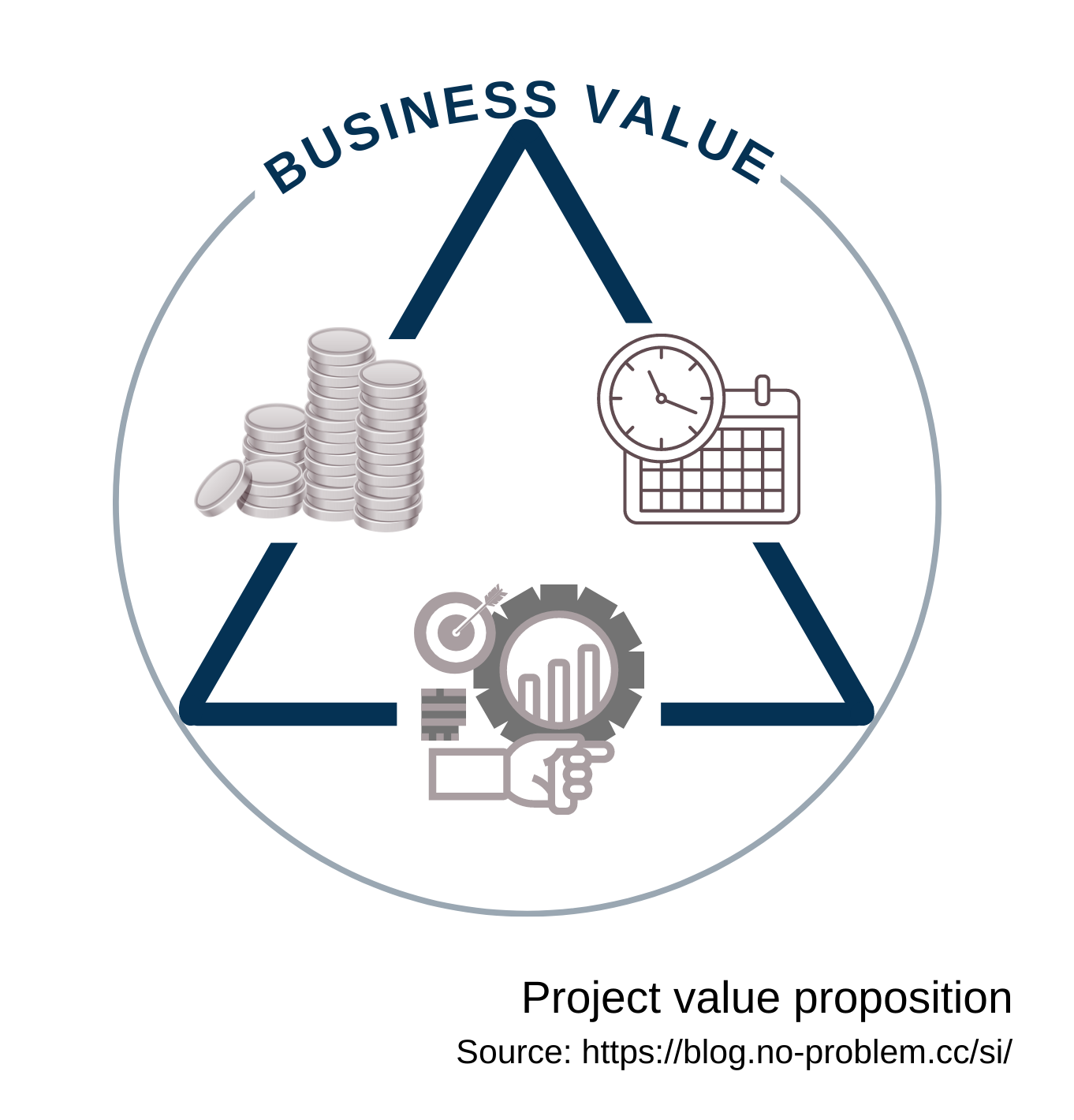 As a rule, to start a project regardless of its basic parameters (size, complexity, business area specifics), primary focus (internal or external), and the expected outcome (a product, a service, or a result) it is necessary to have unambiguity among these aspects and a mutual general vision on targets, processes, opportunities, and constraints, shared by involved parties. Clarity on the project’s value is a starting point and an ultimate pre-requisite for your successful project journey, which follows by creating a project statement, definition of objectives, and elaboration of a project plan.
As a rule, to start a project regardless of its basic parameters (size, complexity, business area specifics), primary focus (internal or external), and the expected outcome (a product, a service, or a result) it is necessary to have unambiguity among these aspects and a mutual general vision on targets, processes, opportunities, and constraints, shared by involved parties. Clarity on the project’s value is a starting point and an ultimate pre-requisite for your successful project journey, which follows by creating a project statement, definition of objectives, and elaboration of a project plan.
Defined scope and objectives
Fuzzy project objectives can grow a large onion and stimulate a waste of resources and efforts. To avoid it, objectives and project success criteria have to be defined and affirmed. Often project objectives are set based on the S.M.A.R.T. principle, i.e. there are to be specific, measurable, achievable, relevant, and time-bound. They are tightly linked to a project’s scope and influence its filling and defining what is included in the project and what is not. A negligent scope is a good manure for onion, which creates a risk of missing some or all project targets.
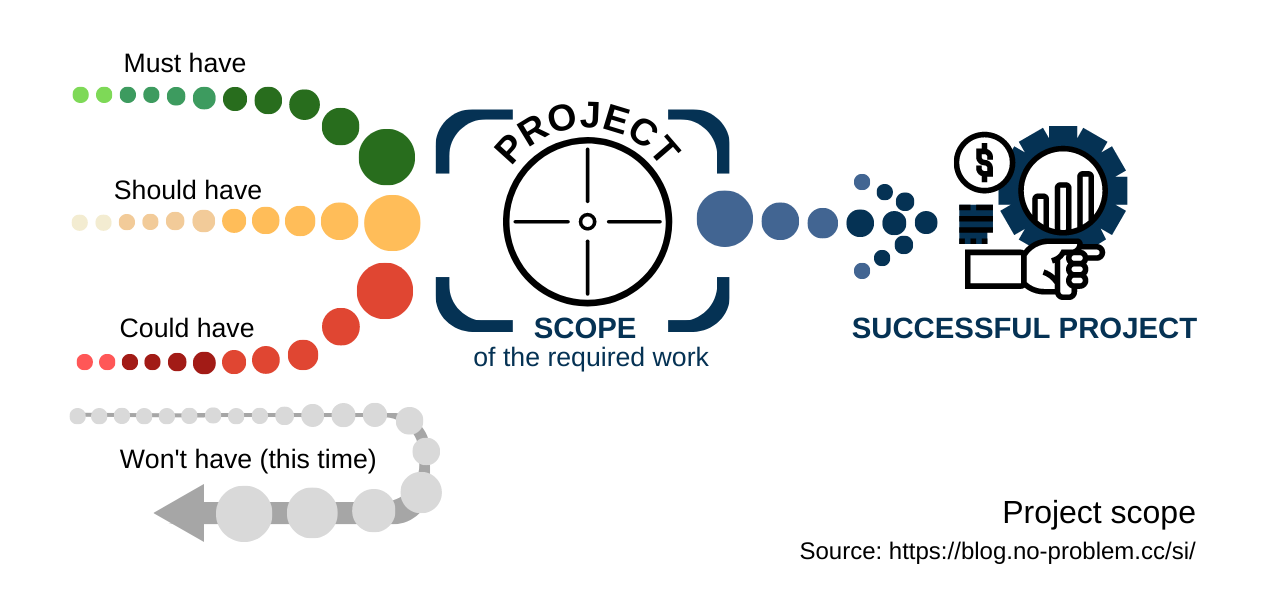
A well-defined scope means that it includes all the work required, and only the work required, to complete the project successfully and meet the acceptance criteria. It is measured against the project management plan. The total scope of work to accomplish the project objectives and create the required deliverables is to be hierarchically decomposed into small parts for which cost and duration are estimated and managed. That structuring usually helps to straighten your path to project success and carefully audit the constraints’ landscape.
Accounted constraints
Each company has its own vision, strategy, and business targets that predefined directions of project objectives and outcomes. Internal and external business environments limit the options available to a company during a project, which have to be managed under certain circumstances and constraints. Focusing on results and positive thinking considering no limitations cultivates onion and assassinates the success of a project. Project constraints can be clustered into six categories: time-related, cost or budget-related, quality-related, scope-related, resources-related, and risk-related. Depending on the project, these groups can have different priorities, however, all of them should be accounted for and tracked.
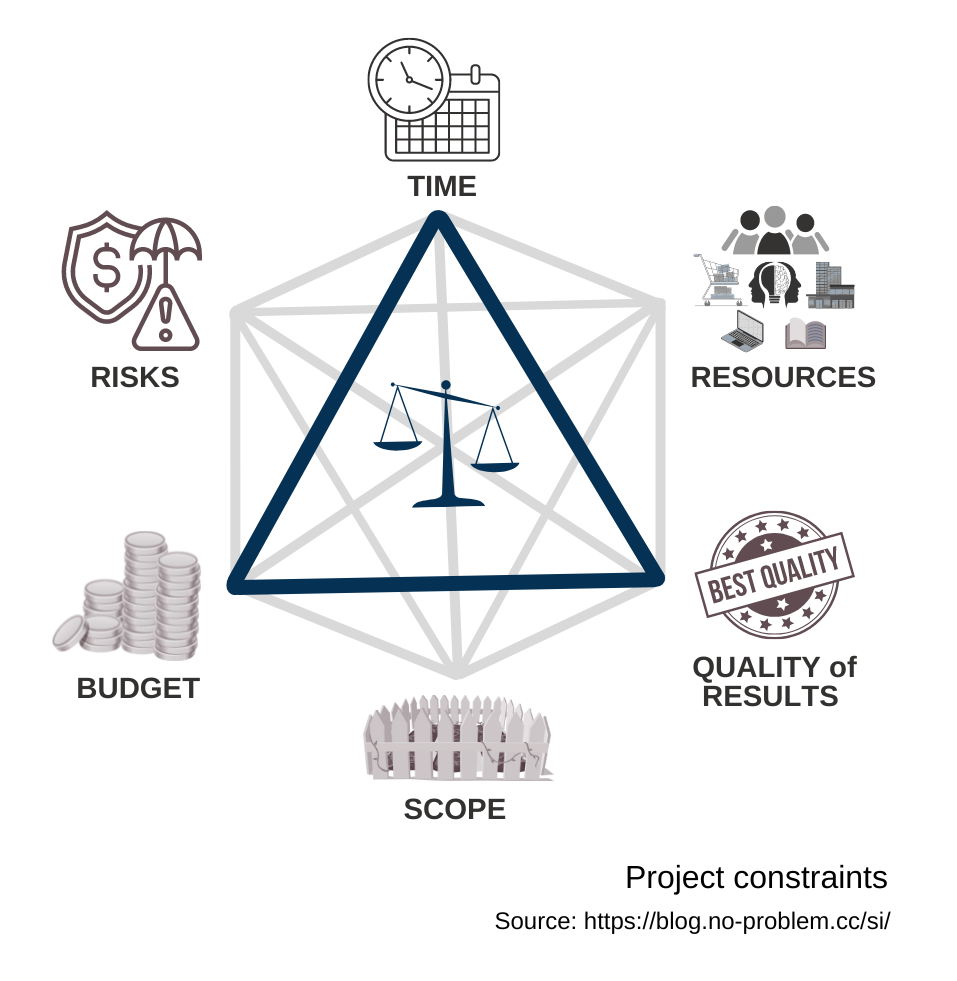 A change in one constraint often impacts the others.
The most sensitive to any variation and vital for a project’s success is a triangle: time—cost—quality. Substantial or uncontrolled changes in it might be a sign of the “onion syndrome” in a project. The larger the bulb, the more difficult it is to balance and manage this triple, the other constraints are or will be also strongly affected, and project success becomes hardly achievable. Awareness of possible limitations allows for analyzing, monitoring, and controlling them, and making informed decisions during a project to take the required corrective actions.
A change in one constraint often impacts the others.
The most sensitive to any variation and vital for a project’s success is a triangle: time—cost—quality. Substantial or uncontrolled changes in it might be a sign of the “onion syndrome” in a project. The larger the bulb, the more difficult it is to balance and manage this triple, the other constraints are or will be also strongly affected, and project success becomes hardly achievable. Awareness of possible limitations allows for analyzing, monitoring, and controlling them, and making informed decisions during a project to take the required corrective actions.
Reliable planning
Planning is a must-have step in any project regardless of its type, selected methodology, and life cycle. It aggregates, clarifies and structures data, sequences, estimates and plans activities to fulfill the prescribed project work. The outcome of the planning step is a project plan, which shapes the desired path to project success and furnishes the basis for tracking and controlling constraints and their deviations. Although usually the initial project plan is modified over time to reflect changes in external and internal environments, it is important to take planning seriously and perform it with accuracy and rational detailing. Reliable project planning reduces uncertainty, anchors the optimal track to project success, makes project work manageable, alarms gaps and contradictions, and provides a solid ground to notice at an early stage an appearance of the “onion syndrome” as well as advantages to shut its effects on the project.
Committed stakeholders
One of the managed project objectives should be stakeholder satisfaction. People, groups, or organizations that could impact or be impacted, or perceive themselves to be affected by the project, are called stakeholders. They are to be identified, analyzed, prioritized and monitored, and the right strategies for their engagement during different project phases have to be developed in order to keep stakeholders satisfied and committed. Often, stakeholder satisfaction is a cornerstone of project success or failure. The key to stakeholder engagement is the focus on continual communication to understand their needs and expectations, in-time address issues, manage conflicting interests, and foster appropriate involvement in decisions and activities. Effective and efficient stakeholder communication ensures that the right message with the right content is delivered to the right person through the right channel at the right time. Once stakeholder satisfaction or commitment is missing, the path of the project can take a bulb, curve, spiral, or another fancy shape, but not the desired straight one.
Skilled and motivated team
The project team belongs to the key stakeholder group with the biggest impact on project success. Therefore, it is vital that a project team possesses the needed competencies and skills to fulfill work and tasks during different project phases and under a project plan to achieve the set targets and objectives. Lack of qualification of executors is one of the common causes of project incompletion, inferior quality of results, or significant increase in budget, time, and efforts spent on the project.
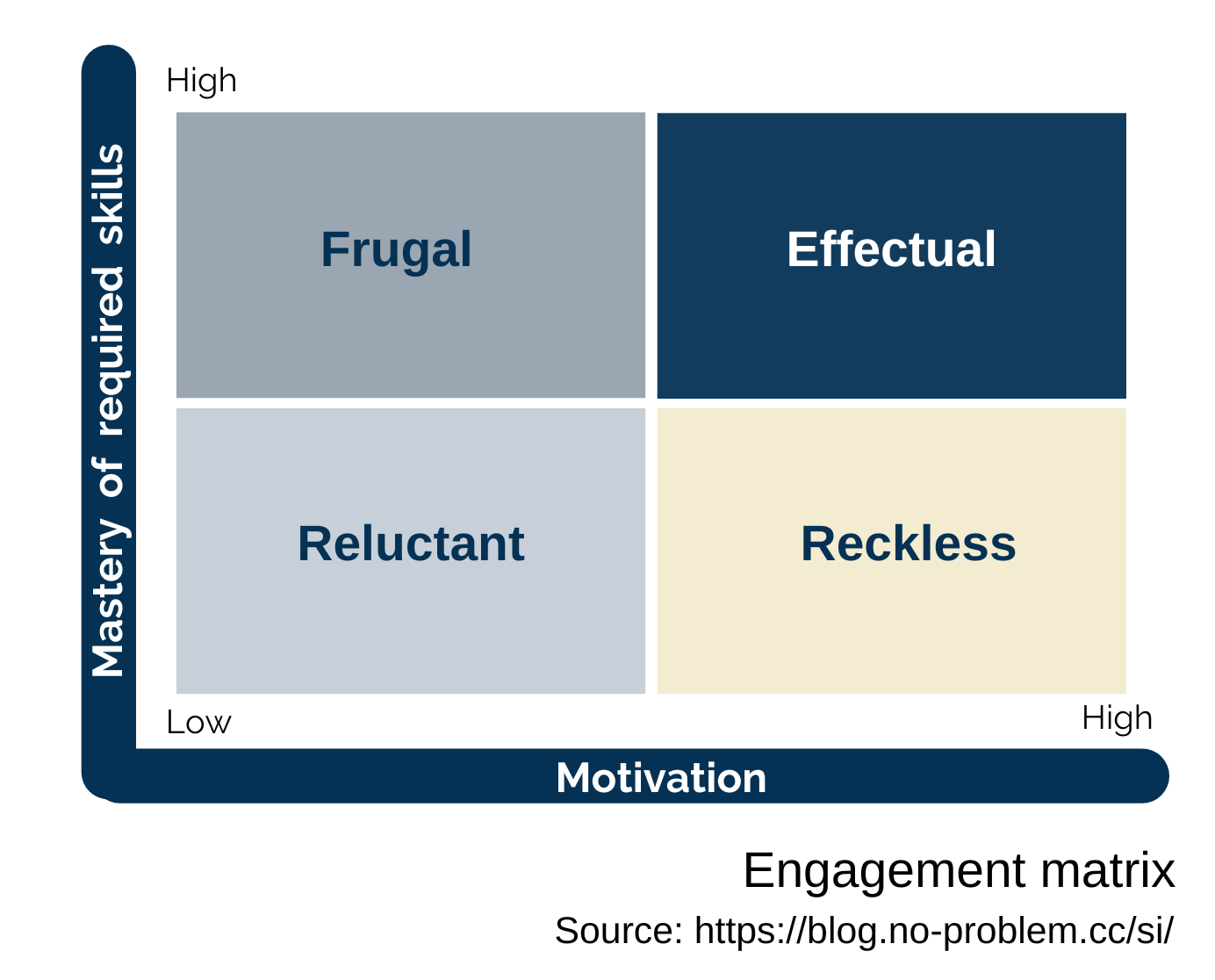 Inaction or implicit faith in the outstanding ability of a project team to settle everything usually makes the situation worse. In order to close skills and competency gaps, requires their identification and then upskilling of team members or hiring the required competence on the market.
Besides skills, another essential aspect is motivation. Only motivated team members can be successfully engaged in a project and will do their best to achieve the desired results in an efficient and thoughtful manner. Once motivation is missing, it immediately affects the team’s commitment and the project path significantly deviates from the planned one.
Inaction or implicit faith in the outstanding ability of a project team to settle everything usually makes the situation worse. In order to close skills and competency gaps, requires their identification and then upskilling of team members or hiring the required competence on the market.
Besides skills, another essential aspect is motivation. Only motivated team members can be successfully engaged in a project and will do their best to achieve the desired results in an efficient and thoughtful manner. Once motivation is missing, it immediately affects the team’s commitment and the project path significantly deviates from the planned one.
Flexing through the project
Managing a project incorporates dealing with variations: stakeholders’ attitudes and commitments are mutable and transform over project phases; internal or external business landscape can curve in another direction and strengthen some constraints; minor and big mistakes in planning and estimating show up and many others expected, foreseeable, and unpredictable changes might occur. It is worth setting up reliable systems and processes that allow for identification, analysis, (re)planning, monitoring, controlling, and reacting to variable deviations and changes during the project, and keep focusing on the project’s vision while implementing adjustments. A pronged approach to execution in a combination with system thinking and timely decision-making support conscious flexibility targeted to project success and smoothing out the project path to it.
The beauty of projects is that they are dynamic, changing over time, and reflecting internal and external surroundings. At the same time, they require clear objectives, organization, structure, and processes, profound planning, monitoring and control, committed stakeholders and qualified executors to make targets real. There are a lot of traps and hindrances, including the “onion syndrome” in projects on the way to their success. However, learning, understanding, and practicing in project management aid to overcome obstacles and achieve outstanding results.
Read this article on Medium

